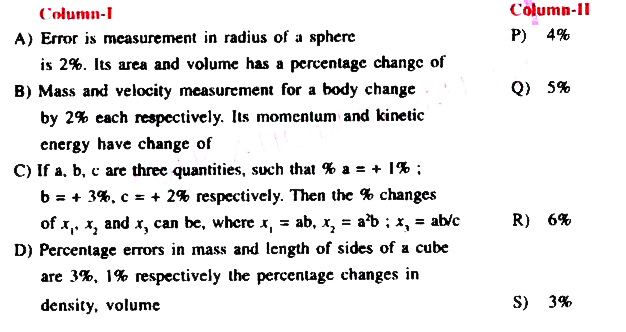In column - I names of measuring instruments are mentioned and column - II possible type of errors are specified - Match the columns appropriately.
Column - IColumn - II(A)Vernier callipers(P)Back lash error(B)Screw gauge(Q)Positive zer error(C)Travelling microscope(R)Negative zero error(D)Meter scale(S)No error
The correct Answer is:A-QRS; B-PQRS; C-PQRS; D-S
To solve the problem of matching the measuring instruments in Column I with their corresponding types of errors in Column II, we will analyze each instrument and identify the possible errors associated with them.
1. Identify the Instruments and Errors:
- Column I contains:
- A) Vernier callipers
- B) Screw gauge
- C) Travelling microscope
- D) Meter scale
- Column II contains possible types of errors:
- P) Backlash error
- Q) Positive zero error
- R) Negative zero error
- S) No error
2. Analyze Vernier Callipers (A):
- Vernier callipers can have:
- Positive zero error (Q)
- Negative zero error (R)
- No error (S)
- Match: A → Q, R, S
3. Analyze Screw Gauge (B):
- Screw gauge can have:
- Positive zero error (Q)
- Negative zero error (R)
- No error (S)
- Match: B → Q, R, S
- Note: Screw gauge does not have backlash error (P).
4. Analyze Travelling Microscope (C):
- Travelling microscope can have:
- Backlash error (P)
- Positive zero error (Q)
- Negative zero error (R)
- No error (S)
- Match: C → P, Q, R, S
5. Analyze Meter Scale (D):
- Meter scale is generally considered to have:
- No error (S)
- It does not typically have backlash error (P), positive zero error (Q), or negative zero error (R).
- Match: D → S
6. Final Matching:
- A → Q, R, S (matches with positive zero error, negative zero error, and no error)
- B → Q, R, S (matches with positive zero error, negative zero error, and no error)
- C → P, Q, R, S (matches with backlash error, positive zero error, negative zero error, and no error)
- D → S (matches with no error)
Summary of Matches:
- A → Q, R, S
- B → Q, R, S
- C → P, Q, R, S
- D → S
Final Answer:
- A → Q
- B → Q
- C → P
- D → S
- Column I contains:
- A) Vernier callipers
- B) Screw gauge
- C) Travelling microscope
- D) Meter scale
- Column II contains possible types of errors:
- P) Backlash error
- Q) Positive zero error
- R) Negative zero error
- S) No error
- Vernier callipers can have:
- Positive zero error (Q)
- Negative zero error (R)
- No error (S)
- Match: A → Q, R, S
- Screw gauge can have:
- Positive zero error (Q)
- Negative zero error (R)
- No error (S)
- Match: B → Q, R, S
- Note: Screw gauge does not have backlash error (P).
- Travelling microscope can have:
- Backlash error (P)
- Positive zero error (Q)
- Negative zero error (R)
- No error (S)
- Match: C → P, Q, R, S
- Meter scale is generally considered to have:
- No error (S)
- It does not typically have backlash error (P), positive zero error (Q), or negative zero error (R).
- Match: D → S
- A → Q, R, S (matches with positive zero error, negative zero error, and no error)
- B → Q, R, S (matches with positive zero error, negative zero error, and no error)
- C → P, Q, R, S (matches with backlash error, positive zero error, negative zero error, and no error)
- D → S (matches with no error)
- A → Q, R, S
- B → Q, R, S
- C → P, Q, R, S
- D → S
- A → Q
- B → Q
- C → P
- D → S
Similar Questions
In column - I some physical situations are mentioned, in column - II corresponding variations of resultant quantities percentasge errors are mentioned. Match column - I entries appropriately with column - II entries

View SolutionMatch the columns
Column-AColumn-B(a)Ribs(i)26(b)Vertebrae(ii)14(c)Phalanges(iii)1(d)Sternum(iv)24
View Solution
Knowledge Check
Match the column I with column II and mark the appropriate choice
Column IColumn II(A)Borax-bead(i)Alum(B)Inorganic benzene(ii)Diborane(C)Antiseptic(iii)Metaborate(D)Bridged hydrogens(iv)BorazineA(A) → (i), (B) → (iii), (C ) → (ii), (D) → (iv)B(A) → (iii), (B) → (iv), (C ) → (i), (D) → (ii)C(A) → (iv), (B) → (iii), (C ) → (i), (D) → (ii)D(A) → (ii), (B) → (iii), (C ) → (vi), (D) → (i)
Match the following
Column-IColumn-II(A)Enthalpy(p)Extensive property(B)Entropy(q)H - TS(C)Free energy(r)E + PV(D)Pressure(s)Intensive property
View SolutionMatch the Column I with Column II.
Column IColumn II(Plant)(Vegetative reproduction by )(a)Turmeric(i)Stolon(b)Crocus(ii)Rhizome(c)Vallisnerla(iii)Aerial shoot(d)Opuntia(iv)Corm
View SolutionColumn-I and Column-II contains four entries each. Entries of Column-I are to be matched with some entries of Column-II One or more than one entries of Column-I may have the matching with the same entries of Column-II.
ColumnIColumnII(A)Electron(P)Negative charge(B)Proton(Q)Positive charge(C)Neutron(R)1.6×10−19C(D)Positron(S)Chargeless
View SolutionMatch the column I with Column II:-
Column IColumn II(A) Unicellular(i) Spirogyra(B) Colonial(ii) Kelps(C) Filamentous(iii) Volvox(D) massive plant bodies(iv) Chlamydomonas
View SolutionMatch the column I with column II
Column-IColumn-II(A)Natural rubber(p)Thermosetting polymer(B)Nylon-66(q)Homopolymer(C)Bakelite(r)Butadiene & styrene(D)Buna-S(s)Polyamide(t)Copolymer
View SolutionMatch the column I with column II
Column-IColumn-II(A)Fructose(p)Protein(B)Zwitterion(q)Inversion(C)Peptide linkage(r)α−Amino acid(D)Hydrlysis of cane sugar(s)Carbohydroate(t)Ketose
View SolutionMatch the reactions given in column I with the type of reaction mentioned in column II and mark the appropriate choice

View Solution
